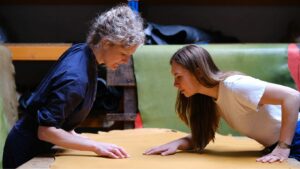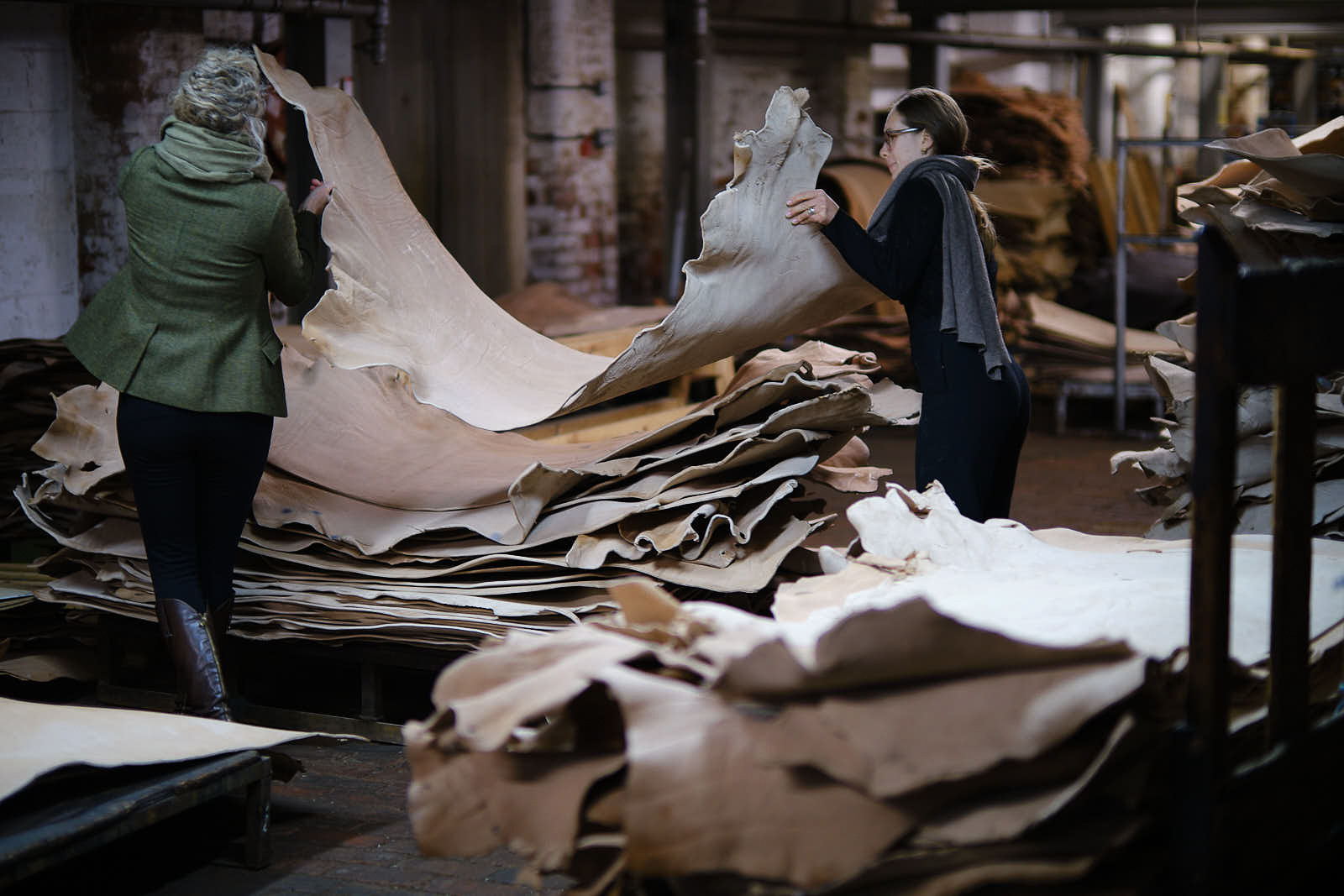Tell us more about your background?
Alice Robinson
I grew up in Shropshire close to where my father’s family is from. I lived there until I left to go to University in London – to train as a Pattern Cutter for my Foundation degree and then went to Edinburgh University to study Womenswear. As long as I can remember I’ve wanted to make things and hoped I would pursue this passion in my education.
My final studies took place at the Royal College of Art where my focus was accessory design. I’d found it quite crushing that the moment you showed your collection, the first question was always – ok what’s next? Because everything I had just made was about lasting a long time! I wanted to create products that had durability built into them, both emotionally and materially.
This was when I was introduced to leather. At that time it was the material of choice to create accessories with and was not surrounded by much of the debate it attracts today. Leather became an exciting material for me to work with because of its reputation as a durable and luxurious material, but also because of all of the stories it could hold within it.
What inspired me?
I have a huge love of the countryside! My late father was a farm vet so being amongst a farming community was a large part of our lives.When I looked at leather, I really wanted to understand the material better. What animal has this come from? Why are these marks there on the surface and what systems or practices were behind its creation?? The material seemed to have been plucked from one world and landed anonymously on my desk in London. But the answers were not easily available so it became inspiring to me – something to really learn more about. And at the same time, the conversations we had amongst our student cohort around leather and its connections to agriculture and sustainability were developing.
I started looking at leather from a point of enquiry and wanted to explore this further and examine the existing narratives. As a material that is defined as a by-product of the meat industry, leather has become disconnected – perhaps because it has often been treated as worthless. I went back to the farming community that I had grown up in. To understand the material and its connection to an animal’s life, the rearing of that animal for food and its landscape.
I bought a sheep from a local farmer and decided to create a collection by working only with the fibres (wool and leather) from that sheep. I served the meat of the sheep at the showcase of Collection 11458, sparking conversations about why we feel so uncomfortable confronting the inescapable truth that leather, and therefore fashion, originates in our food systems..
By this point I had graduated. I followed on to create a collection called Bullock 374. This work involved spending a year learning from a local nature friendly farmer and gaining insight on the many stories that are hidden within leather goods. Creating the collection was an opportunity to learn and shift from commentary, to research and into action. The collection was subsequently shown at the V&A museum’s exhibit FOOD: Bigger than the Plate and I have since written about that journey in my new book Field, Fork, Fashion: Bullock 374 and a designer’s journey to find a future for leather
From the feedback I received, an opportunity became apparent to look at creating leather with a clear and visible link to agriculture. At this point I was introduced to Sara Grady, my British Pasture co-founder. From the farming community side and the design side – we were both looking at the hidden provenance of leather.
Sara Grady
I’m originally from New York City – so I’m very much a city kid!
My career background covers diverse areas. As a young person, I was involved n art, theatre, dance and music. I studied film production and worked in media production as a producer on films, TV, music videos and commercials and then moved to digital media. I have always approached my work with a sense of curiosity, and that led me to work in documentary style and educational content.
I loved the production process, but eventually I reached a crossroads: I didn’t want to just comment on things that had already happened. I needed to find a way to participate in things that interested and concerned me. I actually reached a point where I was producing a TV show and I didn’t even own a television! I decided I wanted to do something that was closer to nature and would give me agency in responding to societal and planetary crises. Something that was not only inspiring but would give me a lifetime of learning.
I identified food as the sector where all those interests and concerns overlapped. I found a way to start working on food systems issues. At that time it was not as developed a sector as it is now. I am envious of young people who are lucky to have the opportunity for a degree in sustainable food systems!
I built a relationship with an organisation in the Hudson Valley region. Initially by volunteering as a filmmaker and making media for their fundraising purposes. In doing that, I became an expert on their programmes which were under development at the time. I became a Programme Director and then the VP of Programmes for Glynwood Centre of Regional Food and Farming. I spent several years in a leadership position across a range of food and agriculture issue led programmes.
What inspired me?
For me personally it was a tremendous time to learn and put all my learned creative skills into service for the things that I personally cared about. It was where I learned about agriculture and food production and that is where my interest in animal hides began.
I had been a vegetarian from the age of 13 but when I got involved in food system topics, I began spending more time looking at sustainable, high quality farming. I developed a much more accurate picture about the realities of animals raised for food. Getting involved with the small independent, sustainable farmers in the Hudson Valley – a similar landscape to the UK – for grazing animals and producing high quality meat, gave me a whole new understanding. I began to learn it is possible to raise animals in a way that honours their welfare.
In fact those grazing animals are incredibly important to the farm ecosystems and to the landscape. Holistically and thoughtfully managed livestock systems actually bring incredible benefits to people, farm ecosystems and biodiversity.
I went from being vegetarian to becoming an omnivore with a strong belief in using all parts of the animal – and this wonderful British term,“nose to tail eating”. I felt that meaningfully using the whole animal demonstrates respect for its life.
At the same time, I was creating programmes to instil similar values amongst professional chefs. One of the ways we did this included demonstrations of humane animal slaughter. It was incredibly important to us to do this honestly and deliver those experiences.
In addition, few farmers actually knew what happened to the hides of the animals. I started investigating and realised through talking to the abattoirs, that the hides get lost – becoming invisible in a global system of trading. And yet there was a tannery just an hour away, so I began delivering small experimental batches of hides to the tannery, just to explore the possibility of making leather that was connected to local farms.

(Alice left & Sara right)
How did you meet Alice, your co-founder?
When I moved to Europe, a chef friend of mine, who knew of my interest in leather, heard Alice speak and suggested I should talk to her. We had a conversation and Alice shared that designers she knew were also looking to explore the source of their materials. We met in person to continue our dialogue but then came the pandemic. Alice was in Shropshire and I was stuck in London. I wasn’t planning on living here – but this idea of producing leather that was fully sustainable and traceable, stayed with us both and we just decided to go for it!
We had to recognise however that we needed to create a fit within current existing industry processes. But we were determined to produce in the UK and have a vegetable tanning process. These types of facilities have closed extensively in the UK – there are only a few tanneries left, thankfully one has been willing to work with us.
Personal Highs and Lows?
(Alice) One of my highs was the very first batch of leather we made. We got some funding from the Royal Countryside Fund and worked with farmers who were all taking their animals to the same abattoir. We needed to mark all the hides individually (we now have a specialised tool for this!) We had handmade tools. It was in the winter. Incredibly cold. And to me that was a real ‘high point’. We were putting 50 cattle hides (rather than 2-3) into tanneries and we had a great day doing it – it was a big occasion. It had taken so much work to get there. But we knew that at least the journey had begun – even though our hands were frozen!
(Sara) One of my high points was the exhibition for the London Design Festival last year. We had an idea to create a small-scale event that combined leather products and meat from the same farms. Through some friends and colleagues, we had the opportunity to locate it at Rochelle School, which includes Rochelle Canteen. The event however became much bigger. Each time we asked someone to make something for the show – they said yes! From Mulberry to New Balance to Bill Amberg.
We set up a display showing visitors the process with imagery and the products that had resulted. Margot Henderson’s team cooked food including meat from the same farms as the hides we have used for leather.
Our opening reception was very moving for us because we had people from across the entire spectrum of the process there in person – including farmers, an abattoir operator, leather industry, designers and makers all together for one event – it was very gratifying because they are inherently connected but rarely if ever together in person.
A more recent highlight was taking brand representatives and designers to two of the farms we work with in Surrey – part of the Textile Exchange Conference. It was another important moment. We know values shift when there is a visceral experience. And what’s more, we received an Award from the Textile Exchange.
“We want to redefine how leather is understood, starting with its agricultural origins — and continuing with an appreciation of its longevity, durability, and repairability. We love the way ‘It’s a Long Story’ champions as a material with many stories.”
Our focus now is about creating visibility. We have so much content to share!!
What are your plans for British Pasture?
British Pasture Leather is producing leather from the hides of cattle raised on regenerative farms in the UK. It is differentiated by the fact we are giving buyers and users of leather a choice. To choose material that they know comes from positive systems that benefit animals, land and people.
British Pasture Leather is a supporter of our online exhibition It’s A Long Story. It’s A Long Story is designed to take visitors on a rich and inspiring digital journey celebrating the long lasting, circular, repairable, upcycling and recycling qualities that leather can offer.
Website: https://britishpastureleather.com/
Instagram: @british.pasture.leather or https://www.instagram.com/british.pasture.leather/
Photo credits: Jason Lowe (www.jasonlowe.eu)
